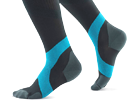| Compression Stockings for Nurses8 October 2015 | John Nurses around the world work incredibly hard to give the best patient care possible. Part of the incredible work nurses do involves being on their feet for a long time, which can take its toll on legs. Here at Compression Stockings we want to help nurses be at their best so that you can continue to deliver great levels of care to patients. What Do Compression Stockings Do?Compression stockings apply pressure to legs. This compression helps to increase circulation and blood flow by stimulating the natural pumping mechanism in muscles, helping to move blood up the leg more efficiently. They’re most often used to help treat venous and lymphatic conditions like deep vein thrombosis and lymphoedema, but they can also help nurses out on the ward. How Can Compression Stockings Help Nurses?There’s two main ways compression stockings can help nurses carry out their duties. Firstly, the increase in blood flow helps reduce the fatigue being on your feet for several hours at a time. This is vital, especially for student nurses who can’t afford to be marked down for sitting while on the job. Because leg fatigue can reduce cognitive function (which is the last thing anyone wants in their medical practitioners), it’s very important that you take whatever steps you can to keep your legs going. The other way compression stockings can help nurses is much more long-term. Over time, without the support compression stockings can offer, spending that long on your feet can cause problems in your leg to develop. The most common problem nurses develop after a few years is varicose veins. This is where the valves in your veins which help blood flow upward fail, causing blood to pool in your veins and them to swell. These are usually nothing to worry about, but look unpleasant and can be painful in some circumstances. Wearing compression stockings can help prevent varicose veins from developing or worsening. When Should Nurses Start Wearing Compression Stockings?Ideally, as soon as possible. The problems which can affect nurses (like varicose veins) take a while to develop, but the sooner you start wearing them the less likely you are to have a problem with these conditions. Also, the last thing student nurses need is to be marked down for sitting, so the sooner you start being able to stand for long periods comfortably the better. What Compression Stockings Should Nurses Wear?This depends entirely on your personal preference and needs. Some nurses don’t wear above 20 mmHg (millimetres of Mercury, a unit of pressure), and others do. It’s a good idea to start low and work your way up to find the right level of compression you need. Compression below 10 mmHg isn’t that efficient at boosting circulation, so it might be a good idea to start there. When looking for compression stockings, check the indications for tired legs (or similar). You should always consult a doctor before wearing compression stockings, as they are medical equipment and incorrect compression can cause other problems to develop or worsen. If you’re interested in getting your hands on some compression stockings for nurses, head on over to Compression Stockings and check out our range of products categorised by compression level. |







